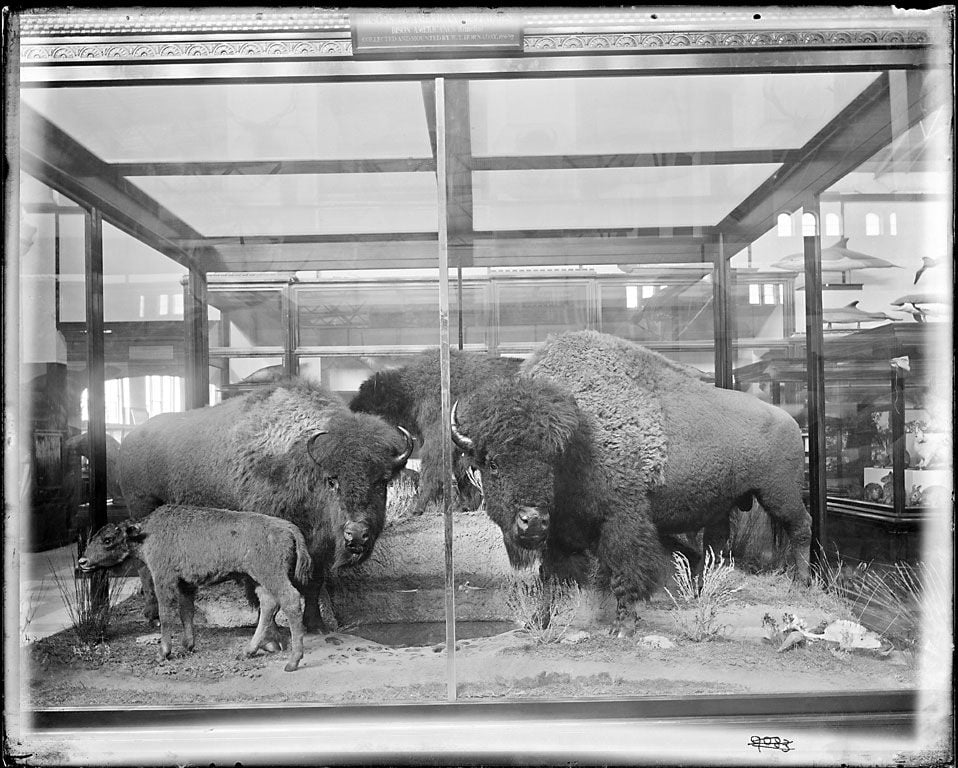The Historic Return of the American Bison
A National Zoo exhibition featuring the animal, long tied to Smithsonian history, opens Saturday
/https://tf-cmsv2-smithsonianmag-media.s3.amazonaws.com/filer/d6/43/d643a22e-f5d0-40b9-ae69-967cc6b05642/14860232140_783e1aff52_b.jpg)
When a group of Smithsonian curators began dismantling a taxidermied bison display in the 1950s, they discovered a mysterious metal case embedded underneath. Inside the case was a letter. “My illustrious successor,” it began. “The old bull, the young cow, and the yearling calf were killed by yours truly. When I am dust and ashes, I beg you to protect these specimens from deterioration and destruction.” It was signed W.T. Hornaday.
The curators surely recognized the name. Dead for two decades by then, William Temple Hornaday had come to the Smithsonian as a taxidermist in the late 1800s, helped establish the National Zoo, and was considered the founder of the American conservation movement. Of his many contributions to the Institution, however, his message from beyond the grave suggests that he was most proud of his bison collection. Now, the National Zoo is honoring Hornaday’s historic work with an exhibition featuring two bison, the names of which were announced this morning.
"Things are really coming fully circle now with this history," says Doug Coffman, who has studied the history of bison at the Smithsonian. Two animals from Montana make up the Zoo's “American Bison” exhibition. Students from Howard and Gallaudet universities collaborated with the Zoo to name the animals, since both schools use the bison as their mascots. Wilma and Zora, as they will be known, arrived at the Zoo on July 10. Keepers have spent the past month and a half helping them acclimate in time for the exhibition, which opens Saturday, August 30.
The exhibition coincides with the Zoo’s 125th anniversary. Bison were the first animals at the National Zoo, and Wilma and Zora will occupy the same location that the originals did more than a century ago. “These two girls are so amazingly solid,” says keeper Marty Dearie. “We’ve all been blown away by how easygoing they seem to be and how willing they are to try new things.” That’s not what you would expect from a pair of one-year-olds, especially some that weigh at least 500 pounds each. “I love their personalities,” Dearie says, “how inquisitive, how eager they are.”
In addition to the Zoo anniversary, there’s another reason to celebrate the bison; thanks to efforts that began with Hornaday’s work, bison have returned from near extinction. “It’s a great conservation story,” says Steve Sarro, the Zoo's exhibition curator.
As chief taxidermist for the Smithsonian in the 1880s, Hornaday traveled west to collect bison to mount for a collection. Decades earlier, tens of millions of bison had roamed the American prairie. “It would have been as easy to count or to estimate the number of leaves in a forest as to calculate the number of buffaloes living at any given time during the history of the species previous to 1870,” Hornaday wrote in The Extermination of the American Bison, using the term buffalo to mean bison. But when he arrived there in 1886, he was shocked to find that there were nearly no bison left.
“I don’t think it ever occurred to people that they could disappear,” says Pamela Henson, an institutional historian at the Smithsonian. “He’s shocked that this magnificent animal that’s distinctly North American is just about gone.”
After finding a handful of bison to mount, believed to be among the last wild bison in the country at that time, Hornaday convinced his Smithsonian colleagues to allow him to start a live collection. They granted him permission, and upon returning to Washington, D.C., Hornaday established a display of six mounted bison and brought living ones to graze behind the Smithsonian Castle. Within a few years, the National Zoo was born. And so was the conservation movement.
Today’s bison are the first to be on view at the National Zoo in more than a decade. And while they are making a celebrated return, Hornaday’s historic mounted collection almost disappeared forever. After finding his note in the 1950s, the curators donated the six bison to collections in Montana. Over the subsequent decades, Hornaday’s group was split and made its way into storage. No one knew where all of them went, until the 1980s when Coffman made it his mission to find them.

“I understood something about the symbolic nature of the original group,” says Coffman, who is now 66 and lives in Eugene, Oregon. “I just started asking around…I spent several years scouting around Montana, sleuthing out the specimens.” He eventually found all six, each gathering dust in storage facilities scattered throughout the state.
Those original mounted bison now reside at the Hornaday Smithsonian Buffalo and Western Art Gallery in Fort Benton, Montana. But Coffman’s bison work didn’t end there. “I think it’s an obsession at this point,” he says, laughing. He wrote a book on his search, Reflecting the Sublime: The Rebirth of an American Icon, which he will be signing at the National Zoo on Saturday.
Though the species has made a miraculous recovery, the International Union for Conservation of Nature still considers the animal “near threatened.” The World Wildlife Fund estimates there are around 20,500 in the wild. That number is down from 30 to 60 million from before their late 19th century decline.
“The animals to me represent the old America, the old West,” Dearie says. “This country was responsible for basically the almost complete eradication of the species and then this country was responsible for bringing them back from the brink.”
/https://tf-cmsv2-smithsonianmag-media.s3.amazonaws.com/accounts/headshot/MAx2.jpg)
/https://tf-cmsv2-smithsonianmag-media.s3.amazonaws.com/accounts/headshot/MAx2.jpg)